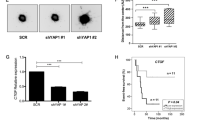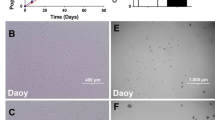Abstract
Medulloblastoma (MB) is the most common malignant brain tumor in children. Recent advances in molecular technologies allowed to classify MB in 4 major molecular subgroups: WNT, SHH, Group 3 and Group 4. In cancer research, cancer cell lines are important for examining and manipulating molecular and cellular process. However, it is important to know the characteristics of each cancer cell line prior to use, because there are some differences among them, even if they originate from the same cancer type. This study aimed to evaluate the similarities and differences among four human medulloblastoma cell lines, UW402, UW473, DAOY and ONS-76. The medulloblastoma cell lines were analyzed for (1) cell morphology, (2) immunophenotyping by flow cytometry for some specifics surface proteins, (3) expression level of adhesion molecules by RT-qPCR, (4) proliferative potential, (5) cell migration, and (6) in vivo tumorigenic potential. It was observed a relationship between cell growth and CDH1 (E-chaderin) adhesion molecule expression and all MB cell lines showed higher levels of CDH2 (N-chaderin) when compared to other adhesion molecule. ONS-76 showed higher gene expression of CDH5 (VE-chaderin) and higher percentage of CD144/VE-chaderin positive cells when compared to other MB cell lines. All MB cell lines showed low percentage of CD34, CD45, CD31, CD133 positive cells and high percentage of CD44, CD105, CD106 and CD29 positive cells. The DAOY cell line showed the highest migration potential, the ONS-76 cell line showed the highest proliferative potential and only DAOY and ONS-76 cell lines showed tumorigenic potential in vivo. MB cell lines showed functional and molecular differences among them, which it should be considered by the researchers in choosing the most suitable cellular model according to the study proposal.




Similar content being viewed by others
References
Aragon-Sanabria V, Pohler SE, Eswar VJ et al (2017) VE-cadherin disassembly and cell contractility in the endothelium are necessary for barrier disruption induced by tumor cells. Sci Rep 7:45835
Arcinas Arthur, Ten-Yang Yen EK, Macher Bruce A (2010) Cell surface and secreted protein profiles of human thyroid cancer cell lines reveal distinct glycoprotein patterns. J Proteome Res 8:3958–3968
Asuthkar S, Guda MR, Martin SE et al (2016) Hand1 overexpression inhibits medulloblastoma metastasis. Biochem Biophys Res Commun 477:215–221
Barrallo-Gimeno A (2005) The Snail genes as inducers of cell movement and survival: implications in development and cancer. Development 132:3151–3161
Blazek ER, Foutch JL, Maki G (2007) Daoy medulloblastoma cells that express CD133 are radioresistant relative to CD133− cells, and the CD133+ sector is enlarged by hypoxia. Int J Radiat Oncol Biol Phys 67:1–5
Calaora V, Chazal G, Nielsen PJ et al (1996) mCD24 expression in the developing mouse brain and in zones of secondary neurogenesis in the adult. Neuroscience 73:581–594
Cao X, Geradts J, Dewhirst MW, Lo HW (2012) Upregulation of VEGF-A and CD24 gene expression by the tGLI1 transcription factor contributes to the aggressive behavior of breast cancer cells. Oncogene 31:104–115
Cavalli FMG, Remke M, Rampasek L et al (2017) Intertumoral heterogeneity within medulloblastoma subgroups. Cancer Cell 31:737–754
Chou YY, Jeng YM, Lee TT et al (2007) Cytoplasmic CD24 expression is a novel prognostic factor in diffuse-type gastric adenocarcinoma. Ann Surg Oncol 14:2748–2758
Cruzeiro GAV, Salomão KB, de Biagi CAO et al (2019) A simplified approach using Taqman low-density array for medulloblastoma subgrouping. Acta Neuropathol Commun 7:33. https://doi.org/10.1186/s40478-019-0681-y
Du J, Wu Y, Liu Y et al (2014) E-cadherin is critical for SC1-induced colony growth of F9 embryonic carcinoma cells. Cell Physiol Biochem 33:501–512
Eberhart CG, Kepner JL, Goldthwaite PT et al (2002) Histopathologic grading of medulloblastomas: a Pediatric Oncology Group study. Cancer 94:552–560
Fonsatti E, Nicolay HJM, Altomonte M et al (2010) Targeting cancer vasculature via endoglin/CD105: a novel antibody-based diagnostic and therapeutic strategy in solid tumours. Cardiovasc Res 86:12–19. https://doi.org/10.1093/cvr/cvp332
Gedye CA, Hussain A, Paterson J et al (2014) Cell surface profiling using high-throughput flow cytometry: a platform for biomarker discovery and analysis of cellular heterogeneity. PLoS ONE 9:e105602
Geng S, Guo Y, Wang Q et al (2013) Cancer stem-like cells enriched with CD29 and CD44 markers exhibit molecular characteristics with epithelial–mesenchymal transition in squamous cell carcinoma. Arch Dermatol Res 305:35–47. https://doi.org/10.1007/s00403-012-1260-2
Grunder E, D’Ambrosio R, Fiaschetti G et al (2011) MicroRNA-21 suppression impedes medulloblastoma cell migration. Eur J Cancer 47:2479–2490
Hawkins K, Mohamet L, Ritson S et al (2012) E-cadherin and in its absence, N-cadherin promotes nanog expression in mouse embryonic stem cells via STAT3 Phosphorylation. Stem Cells 30:1842–1851
He R, Zhang F, Shen N (2017) LncRNA FEZF1-AS1 enhances epithelial–mesenchymal transition (EMT) through suppressing E-cadherin and regulating WNT pathway in non-small cell lung cancer (NSCLC). Biomed Pharmacother 95:331–338
Hendrix MJC, Seftor EA, Meltzer PS et al (2001) Expression and functional significance of VE-cadherin in aggressive human melanoma cells: role in vasculogenic mimicry. Proc Natl Acad Sci 98:8018–8023. https://doi.org/10.1073/pnas.131209798
Ivanov DP, Coyle B, Walker DA, Grabowska AM (2016) In vitro models of medulloblastoma: choosing the right tool for the job. J Biotechnol 236:10–25
Jones DT, Jager N, Kool M et al (2012) Dissecting the genomic complexity underlying medulloblastoma. Nature 488:100–105
Kanatsu-Shinohara M, Takehashi M, Takashima S et al (2008) Homing of mouse spermatogonial stem cells to germline niche depends on β1-integrin. Cell Stem Cell 3:533–542
Krause DS, Mucenski ML, Lawler AM, May WS (1998) CD34 expression by embryonic hematopoietic and endothelial cells does not require c-Myb. Exp Hematol 26:1086–1092
Kumar A, Bhanja A, Bhattacharyya J, Jaganathan BG (2016) Multiple roles of CD90 in cancer. Tumor Biol 37:11611–11622
Lee JM, Dedhar S, Kalluri R, Thompson EW (2006) The epithelial–mesenchymal transition: new insights in signaling, development, and disease. J Cell Biol 172:973–981
Li K, He W, Lin N et al (2009) N-cadherin knock-down decreases invasiveness of esophageal squamous cell carcinoma in vitro. World J Gastroenterol 15:697–704
Liang L, Aiken C, McClelland R et al (2015) Characterization of novel biomarkers in selecting for subtype specific medulloblastoma phenotypes. Oncotarget 6:38881–38900
Louis DN, Ohgaki H, Wiestler OD et al (2007) The 2007 WHO classification of tumours of the central nervous system. Acta Neuropathol 114:97–109. https://doi.org/10.1007/s00401-007-0243-4
Louis DN, Perry A, Reifenberger G et al (2016) The 2016 World Health Organization Classification of tumors of the central nervous system: a summary. Acta Neuropathol 57:301–311
McManamy CS, Pears J, Weston CL et al (2007) Nodule formation and desmoplasia in medulloblastomas-defining the nodular/desmoplastic variant and its biological behavior. Brain Pathol 17:151–164. https://doi.org/10.1111/j.1750-3639.2007.00058.x
Northcott PA, Shih DJH, Peacock J et al (2012) Subgroup-specific structural variation across 1,000 medulloblastoma genomes. Nature 488:49–56
Ouhtit A, Abdraboh ME, Hollenbach AD et al (2017) CD146, a novel target of CD44-signaling, suppresses breast tumor cell invasion. Cell Commun Signal 15:45
Pantazi E, Gemenetzidis E, Teh MT et al (2017) GLI2 is a regulator of β-catenin and is associated with loss of E-cadherin, cell invasiveness, and long-term epidermal regeneration. J Invest Dermatol 137:1719–1730
Pui C-H, Gajjar AJ, Kane JR et al (2011) Challenging issues in pediatric oncology. Nat Rev Clin Oncol 8:540–549
Raso A, Negri F, Gregorio A et al (2008) Successful isolation and long-term establishment of a cell line with stem cell-like features from an anaplastic medulloblastoma. Neuropathol Appl Neurobiol 34:306–315
Read TA, Fogarty MP, Markant SL et al (2009) Identification of CD15 as a marker for tumor-propagating cells in a mouse model of medulloblastoma. Cancer Cell 15:135–147
Ricardo S, Vieira AF, Gerhard R et al (2011) Breast cancer stem cell markers CD44, CD24 and ALDH1: expression distribution within intrinsic molecular subtype. J Clin Pathol 64:937–946
Robinson G, Parker M, Kranenburg TA et al (2012) Novel mutations target distinct subgroups of medulloblastoma. Nature 488:43–48
Rochefort P, Chabaud S, Pierga J-Y et al (2017) Soluble VE-cadherin in metastatic breast cancer: an independent prognostic factor for both progression-free survival and overall survival. Br J Cancer 116:356–361
Rutkowski S, von Hoff K, Emser A et al (2010) Survival and prognostic factors of early childhood medulloblastoma: an international meta-analysis. J Clin Oncol 28:4961–4968
Sandén E, Dyberg C, Krona C et al (2015) Aberrant immunostaining pattern of the CD24 glycoprotein in clinical samples and experimental models of pediatric medulloblastomas. J Neurooncol. https://doi.org/10.1007/s11060-015-1758-5
Siegel R, Naishadham D, Jemal A (2012) Cancer statistics, 2012. CA Cancer J Clin 62:10–29. https://doi.org/10.3322/caac.20138.Available
Singh SK, Clarke ID, Terasaki M et al (2003) Identification of a cancer stem cell in human brain tumors. Cancer Res 63:5821–5828. https://doi.org/10.1038/nature03128
Singh SK, Hawkins C, Clarke ID et al (2004) Identification of human brain tumour initiating cells. Nature 432:396–401. https://doi.org/10.1038/nature03128
Skowron P, Ramaswamy V, Taylor MD (2015) Genetic and molecular alterations across medulloblastoma subgroups. J Mol Med 93:1075–1084
Sneha S, Nagare RP, Priya SK et al (2017) Therapeutic antibodies against cancer stem cells: a promising approach. Cancer Immunol Immunother 233:706–720
Sun L, Moritake T, Zheng YW et al (2013) In vitro stemness characterization of radio-resistant clones isolated from a medulloblastoma cell line ONS-76. J Radiat Res 54:61–69
Ullmann U, In’t Veld P, Gilles C et al (2007) Epithelial-mesenchymal transition process in human embryonic stem cells cultured in feeder-free conditions. Mol Hum Reprod 13:21–32
Woodfin A, Voisin MB, Nourshargh S (2007) PECAM-1: a multi-functional molecule in inflammation and vascular biology. Arterioscler Thromb Vasc Biol 27:2514–2523
Woodford-Thomas T, Thomas ML (1993) The leukocyte common antigen, CD45 and other protein tyrosine phosphatases in hematopoietic cells. Semin Cell Dev Biol 4:409–418
Zanini C, Ercole E, Mandili G et al (2013) Medullospheres from DAOY, UW228 and ONS-76 cells: increased stem cell population and proteomic modifications. PLoS ONE 8:e63748
Zhang K, Che S, Su Z et al (2018) CD90 promotes cell migration, viability and sphere-forming ability of hepatocellular carcinoma cells. Int J Mol Med 41:946–954
Acknowledgments
We thank the Conselho Nacional de Desenvolvimento Científico e Tecnológico (CNPq) and Fundação de Amparo à Pesquisa do Estado de São Paulo (FAPESP) Process Numbers: 2011/18664-7 and 2011/20829-4 for the financial support for this study.
Author information
Authors and Affiliations
Corresponding author
Ethics declarations
Conflict of interest
The authors declare that they have no conflict of interest.
Ethical standards
All the animal procedures of this study were done in agreement with the ETHICAL PRINCIPLES IN ANIMAL RESEARCH adopted by the Brazilian College of Animal Experimentation (COBEA) and this study was approved by the Ethics Committee on Animal Experiments of the Ribeirão Preto Medical School under Protocol Number 137/2011.
Additional information
Publisher's Note
Springer Nature remains neutral with regard to jurisdictional claims in published maps and institutional affiliations.
Rights and permissions
About this article
Cite this article
Bonfim-Silva, R., Salomão, K.B., Pimentel, T.V.C.d. et al. Biological characterization of the UW402, UW473, ONS-76 and DAOY pediatric medulloblastoma cell lines. Cytotechnology 71, 893–903 (2019). https://doi.org/10.1007/s10616-019-00332-3
Received:
Accepted:
Published:
Issue Date:
DOI: https://doi.org/10.1007/s10616-019-00332-3




